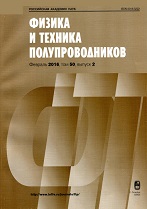|
|
Физика и техника полупроводников, 2021, том 55, выпуск 10, страница 947
(Mi phts6630)
|
 |
|
 |
Эта публикация цитируется в 1 научной статье (всего в 1 статье)
Поверхность, границы раздела, тонкие пленки
Arsine flow rate effect on the low growth rate epitaxial InGaAs layers
I. Demirab, I. Altuntasab, S. Elagozc
a Department of Nanotechnology Engineering, Sivas Cumhuriyet University
b Nanophotonics Research and Application Center, Sivas Cumhuriyet University, 58140 Sivas, Turkey
c Aselsan R&D Management, Ankara, Turkey
Аннотация:
Effect of arsine (AsH$_3$) flow rate on epitaxially grown unintentionally doped and low-growth rate InGaAs layer by using metalorganic organic vapor phase epitaxy at growth temperature (640$^\circ$C) are investigated. While all other sources and parameters are kept constant during growth, the AsH$_3$ flow rate in InGaAs layer is increased from 20 to 120 sccm. The epitaxial grown InGaAs layers have been characterized by optical microscopy, X-ray diffraction, photoluminescence, and Hall effect. It is found that the mobility of carriers increases from 3780 to 7043 cm$^2$/Vs, sheet carrier density decreases from 7.74 $\cdot$ 10$^{11}$ to 4.01 $\cdot$ 10$^{11}$ cm$^{-2}$, PL intensity of emission increases from 1.1 to 8.6 V by increasing the AsH$_3$ flow rate from 20 to 40 scvm. Moreover, the same trend of improvement is observed on the crystalline quality of InGaAs layers with changing of AsH$_3$ flow rate. The changing of AsH$_3$ flow rate between 20 and 120 sccm is found to have strong effect on properties of epitaxial InGaAs alloys.
Ключевые слова:
InGaAs, metal organic vapor phase epitaxy, arsine, V/III ratio, thin film.
Поступила в редакцию: 11.01.2021
Исправленный вариант: 25.05.2021
Принята в печать: 07.06.2021
Образец цитирования:
I. Demir, I. Altuntas, S. Elagoz, “Arsine flow rate effect on the low growth rate epitaxial InGaAs layers”, Физика и техника полупроводников, 55:10 (2021), 947; Semiconductors, 55:10 (2021), 816–822
Образцы ссылок на эту страницу:
https://www.mathnet.ru/rus/phts6630 https://www.mathnet.ru/rus/phts/v55/i10/p947
|


| Статистика просмотров: |
| Страница аннотации: | 64 | | PDF полного текста: | 12 |
|





 Обратная связь:
Обратная связь: Пользовательское соглашение
Пользовательское соглашение
 Регистрация посетителей портала
Регистрация посетителей портала Логотипы
Логотипы








 Цитирование в формате
Цитирование в формате 
